Frank Ernest Joseph Jones
Family
Frank Ernest Joseph Jones was born in Barnstaple in 1893. He was the oldest surviving son of William Thomas Jones and his wife Bessie Ada Willmets. William was from Torquay and Bessie was from Barnstaple; they married in the parish church in Ilfracombe on 29th May 1882. William was a painter and house decorator, as was Bessie's father, Robert Willmets; this may have been how the couple met. Bessie already had a daughter, Phyllis Edith, born in 1881, one month old at the time of the census.
William and Bessie made their home in Barnstaple, near Bessie's parents, Robert and Ann Willmets. Minnie Theresa was born in 1883, followed by Hetty Elizabeth in 1884; sadly, Hetty died the following year, before her first birthday. Florence Emily was born in 1885 and William Ernest in 1887, but William too died in infancy. Two more girls followed, Annie Louise and Nellie Margaret in 1888 and 1889. At the time of the 1891 census, Bessie was pregnant with her seventh child, Hettie Eveline. She was born shortly afterward but sadly died before her first birthday. Ethel Marian was born in 1892, so when Frank arrived the following year, he had six older sisters. The family lived at 42 Hardaway Head, in the centre of Barnstaple. William Jones continued to work as a painter and house decorator.
By 1901, the family had moved to East Pilton, a suburb of Barnstaple. The older girls had left home to work in domestic service: Edith was in Lambeth, in London; Minnie was nearby, in Ilfracombe; and Emily (as she was known) was closer still, in Barnstaple. Still at home were Annie, Nellie, Ethel and Frank; there were also four more girls. Gladys May was born in 1897, Hilda Gwendoline in 1898, and Bessie Ada in 1899; they were all baptised together at the parish church in Pilton on 15th November 1899. Also recorded in the 1901 census was the latest baby, Doris Winifred, aged 5 months. Sadly she died later that year, before her first birthday.
Frank had thus grown up as the only boy in a family of nine girls; but William and Bessie's last two children were both boys. Sydney Robert was born in 1902 and Leonard John in 1903. In the 1911 census, William and Bessie were recorded living in The Rock, Pilton. Gladys May had gone into domestic service in East Ashford, near Barnstaple; but still at home were Frank, Hilda, Bessie, Sidney and Leonard. The four younger children were still at school; Frank, now 17, worked as a labourer in a "cabinet works". William still worked as a housepainter and decorator.
Several of the older girls had married. In particular, Minnie Theresa married Albert John Whitemore, from Dartmouth, in 1904. For Albert's family, see the story of George Edward Whitemore, his brother. Minnie is Frank's connection with Dartmouth and was the reason he is commemorated in the town. She was Albert's second wife; his first, Beatrice Purcell, had died in March 1904, leaving him with a daughter, Beatrice, then just under two years of age. Albert and Minnie married later in 1904; by the time of the 1911 Census, as well as looking after Beatrice, Minnie had two children of her own: Albert John, age 4, and Minnie, age 2. The family lived in Ford Cottages and Albert worked as a bricklayer.
At some point between 1911 and the start of the war, Frank moved to Dartmouth from Barnstaple. According to a piece published in the Dartmouth Chronicle at the time of his death (see below) he was employed at the Royal Naval College as a gardener and lived with Minnie and Albert.
Service
Frank's individual service papers, like so many, have not survived, but "F Jones" was listed as one of those joining "F" Company of the 7th Battalion Devonshire Regiment (Cyclists) in the Dartmouth Chronicle of 16th October 1914. Soldiers Died in the Great War confirms that he enlisted at Dartmouth, and also records that he had previously joined the Devonshire Regiment, number 1179; this number is close to that of Frederick George Coles whom we know joined the Cyclists on 7th August 1914. Several other men who joined the Cyclists at the start of the war are on our database:
See their stories for the Cyclists' experience in the early part of the war.
As part of the Territorial Force, members of the 7th Battalion had no liability for service overseas. But with the introduction of conscription early in 1916, the requirement to honour the restriction on overseas service for men in the Territorial Force no longer applied. In any case, many members of the 7th Battalion had voluntarily undertaken to serve abroad.
Frank Jones appears to have transferred to the 7th Battalion Duke of Cornwall's Light Infantry (DCLI). The 7th Battalion DCLI was formed at Bodmin in September 1914 and was part of 61st Brigade in 20th (Light) Division. They arrived in France on 25th July 1915. Frank's Medal Index Card shows that he did not go overseas during 1914-15, but no information has come to light about exactly when he joined them, though it is likely to have been sometime during 1916.
The battalion began 1916 in the Ypres sector, transferring to the Somme in July 1916 and moving into the front line trenches in August. They remained on the Somme until early 1917. In April 1917, after the German retreat to the Hindenburg Line, they were involved in an attack on German positions in Havrincourt Wood, remaining in this sector until the move back up to Flanders overnight on 20th/21st July. See also the stories of Reginald Pritchard Bawden and William Burnell, who also served in the 20th (Light) Division, in the 6th Ox & Bucks and the 10th Rifle Brigade respectively.
Battle of Langemarck
The role of the 7th Bn DCLI at the Third Battle of Ypres has become well-known because, at that time, the Battalion included Harry Patch, the last surviving combat soldier of the First World War from any country. He arrived in France to join the Battalion in June 1917, and his recorded memories paint a vivid picture of his service during August and September 1917 in particular.
On the 16th August 1917, the 7th Bn DCLI took part in the attack on Langemarck, with the 6th Bn Ox & Bucks (in the 60th Brigade) on their right. They crossed the Steenbeck before dawn. The 7th Bn DCLI followed the 7th Somerset Light Infantry and the 7th Kings Own Yorkshire Light Infantry, being due to "pass through" them when they had taken the first and second objective, so as to take the third objective "the Red Line". "A" and "C" Companies led; "B" and "D" Companies were in support and reserve. Frank appears to have been in "A" Company, see below. Harry Patch was in "C" Company.
As the leading battalions made their attack, the two companies on the right suffered casualties owing to machine gun fire from the direction of the strongpoint "Au Bon Gite" (they were not the only ones - see the story of Reginald Bawden, already referred to). The two left companies "were protected, to a certain extent, by the fall of the ground towards the Railway".
Nonethless the attack was successful and, according to the CO's report in the War Diary:
At Zero plus 1 hour I ordered the Battalion to move forward through Langemarck and form up NE of the village ... We found some KOYLI digging in along the hedge ... this seemed to me to represent the consolidation of the 2nd Objective and it was obvious that this battalion was very weak. I therefore ordered my reserve company to prolong this line towards the Railway with two platoons and dig in ... At 7.20am the remainder of the Battalion moved forward behind the Barrage, two companies in front and one in support ... and advanced to the third objective with little opposition.
Two counter-attacks at about 5pm and 7.30pm were dispersed. The night and the rest of the following day was quiet until the late afternoon, when 7th Bn DCLI was ordered to retake a section of trench which had been lost to the enemy. This they were able to do "without direct opposition but under machine gun fire from the SE which caused a few casualties". The trench was handed over to the KOYLI.
The Battalion was relieved overnight on 17th/18th August and withdrawn to rest and further training.
The Battalion suffered two officers and 41 men killed or died of wounds, and a further 140 were wounded. Frank was fortunate - his name does not appear on the list of wounded which (unusually) is included in the War Diary. In 2008, Harry Patch opened a memorial to his fallen comrades on the bank of the Steenbeck at the point where the Battalion crossed the river "to honour the courage, sacrifice and passing of the Great War generation".
On 12th September the Battalion was back in the front line at Langemarck for several short stints, until 28th September (Harry Patch was wounded during this period, and did not return to the front line with the Battalion). On 1st October, they received orders to move to Bapaume by rail, which they reached the following day: their part in the Third Battle of Ypres was over. But their part in the Battle of Cambrai was about to begin.
Battle of Cambrai
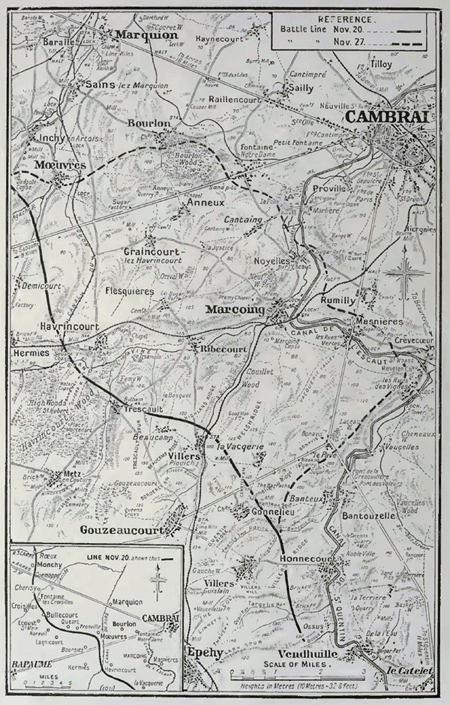
At about this time General Haig gave his final approval for a surprise attack on Cambrai, involving a mass tank attack, mass artillery firing at pre-selected targets of known range and position, and close coordination of tanks, artillery, infantry and aircraft. Cambrai was an important railhead, billeting and headquarters for German forces, but seems to have been selected opportunistically rather than strategically - only two German divisions held the (nearly) six-mile front to be attacked, supported by little artillery. Also, the ground (being chalk not mud) was suitable for tank operations. But the overall aim was ambitious, requiring both the First and Second Line systems of the strongly fortified Hindenburg Line to be overwhelmed, and the St Quentin canal to be crossed, followed by a cavalry attack to sweep round the town and take the Cambrai railway junction, thus enabling the capture of the town and forcing German evacuation of a large area.
The attacking force consisted of six infantry divisions, with one in support (the 29th Division - see the story of Samuel Love); three tank brigades; and three cavalry divisions; supported by aircraft in an assault role. 20th Division was to the south of the front, with 12th Division on the right and 6th Division on the left. They were to carry out "a surprise attack ... with a view to breaking the Enemy's Defensive Line between the Canal de L'Escaut at Banteux and the Canal du Nord west of Havrincourt". The infantry were to follow "waves of Tanks" and "Standing Barrages of Artillery"; there were to be three waves of tank and infantry attack, with infantry and tanks forming up together.
The 61st Infantry Brigade was to the right of the divisional front, with 60th Infantry Brigade on the left. The DCLI's objective was La Vacquerie; "A" and "B" Company were in the first wave (on right and left respectively) and "D" and "C" Company were in the second wave (on right and left similarly).
The attack was launched on 20th November, and was a success:
Platoons were distributed to Tanks ... at 6.10am the first wave moved off, at 6.20am the second wave ... and our barrage began ...One of "B" Coys tanks broke down, otherwise there was no hitch in the advance ... Generally speaking there was little serious opposition and "A" and "B" Coys had captured their objectives by 7am. The second wave with "C" and "D" Coys then passed through and proceeded to capture the Hindenburg Line.
Three more tanks broke down at this stage. But there was little resistance in the trenches of the Hindenburg Line, though machine gun fire caused "considerable casualties". The War Diary reported for that day two officers and 59 men wounded, ten men killed, and eight men missing believed wounded.
The following day 7th Bn DCLI was first ordered to provide support to the 88th Brigade at Masnieres, but this order was then countermanded and instead they held a position at Les Rues Vertes. On 25th November, they moved to the "outpost and support line opposite Les Rues des Vignes", where they were established in dugouts forming part of accommodation previously occupied by German anti-aircraft gun crews. Consequently the entrances faced in the wrong direction and were in full view of the enemy, but although machine gun fire caused "annoyance" there were very few casualties. Here they remained until 28th November, when they were relieved and moved back to "old German trenches NW and SE of the Vacquerie valley where it opened out towards Masnieres."
All seemed quiet; but a key problem facing the British command was how to hold the new salient created by the attack, approximately nine miles wide and four miles deep, and acutely vulnerable to attacks from both sides. While GHQ pondered the problem, in the meantime the German Army brought up substantial reinforcements and planned a major counter-attack, launched early on the morning of 30th November, with a heavy bombardment.
This was a complete surprise all along the new front held by the British. The War Diary records:
The first intimation Battn HQ had of an enemy attack on our front was from an officer of "D" Coy, who reported at about 8am that the troops in front of us appeared to be withdrawing ... Shortly afterwards the enemy appeared in strength attacking from the E and SE ...
"B" and "C" Coys were told to hold their ground and "D" Coy was moved forward to a position where they could fire on the enemy; "A"Coy was sent forward to cover the right flank as the enemy attack seemed to be heavier there. The acting CO was then killed while leading a small group of men to reinforce "A" Coy.
The position was held until the enemy were within 50 yards, but then "B", "C" and "D" Coys had to withdraw to the west to avoid being cut off. "A" Coy was also pulled back and brought back in touch with the rest. Bombing blocks were built to cut off the enemy and touch was established with neighbouring battalions - the position was, apparently, successfully held until the relief overnight on 2nd/3rd December. Once again Frank was fortunate - his name does not appear in the long casualty lists which follow the account of the Battle of Cambrai in the 7th Battalion's War Diary.
Three days later, after a long journey involving marching, buses and trains, with intermediate stops in unsatisfactory billets, what remained of the fighting strength of the 7th Bn DCLI reached a rest camp at Coupelle Vielle, south-west of Saint-Omer. Here "various details rejoined the Battalion", including the Transport and the cooking facilities. New arms, equipment and clothing was ordered, what equipment had survived was cleaned and arrangements made for repair, and "war diaries, narratives, notifications to relatives, and recommendations for awards were completed. The Battalion now numbered, in total, 15 officers and just over 400 men.
On 12th December they moved to Wallon Cappel, east of Saint-Omer, where they were finally able to enjoy a reasonably extended period of rest, including a proper celebration of Christmas in suitably seasonal weather.
Death
On 5th January 1918, they returned to the Ypres front. This was now relatively quiet and casualties were light. On 11th February, the 7th Bn DCLI relieved the 7th Bn Somerset Light Infantry in the front line in the Menin Road and Gheluvelt sector. The War Diary recorded:
Relief complete 8.30pm. Patrols out & working parties improving posts. Situation normal."
On 12th February:
Situation quiet except for TM (trench mortar) activity. 4 men killed in shelter in SP (strongpoint) occupied by A Coy in light support. Patrols working parties & improvement of posts continued.
Frank's luck had run out - the War Diary lists the casualties for February 1918. "29184 Jones F E" was one of the four men killed in the shelter on 12th February 1918. With him were:
- 10839 Nicholson D W - Dudley Walter Nicholson, of Palmers Green, London
- 28903 Northway J - James Northway, of Ashburton, Devon
- 17942 Grose W - William Grose, of St Austell, Cornwall
An article appearing in the Dartmouth Chronicle provides a little more information about Frank's death. It drew readers' attention to the sad coincidence that both Albert and Minnie had received news of the deaths of their brothers within a very short space of time of each other:
A Double Bereavement: Dartmouth Men Killed in Action
Mr Albert Whitemore of 3 Floral Cottages Victoria Road, whose brother George was killed in the Dardanelles on January 20th last in the action between British destroyers and the Breslau and Goeben, has just heard from the Admiralty that the body was buried on January 26th at Panaghia [Imbros] in the Eastern Mediterranean. Unfortunately there has been another exemplification of the old adage that misfortunes never come singly, for Mrs Whitemore has received news that her brother, Private F Jones, who before the war was residing with her, and who joined the colours in 1914, has been killed in a dugout in France by a German shell while reading a newspaper. He was 26 years of age and before the war was employed on the grounds of the Royal Naval College. Mr and Mrs Whitemore have the sympathy of everyone in their sad double bereavement.
Commemoration
It seems that Frank was buried close to where he died. According to Commonwealth War Grave Commission records, Frank's body was found buried at map reference "J.20.b.9.0", and was identified by his paybook and letters. In 1919 his body was reburied at Hooge Crater Cemetery, on the Menin Road, where it remains.
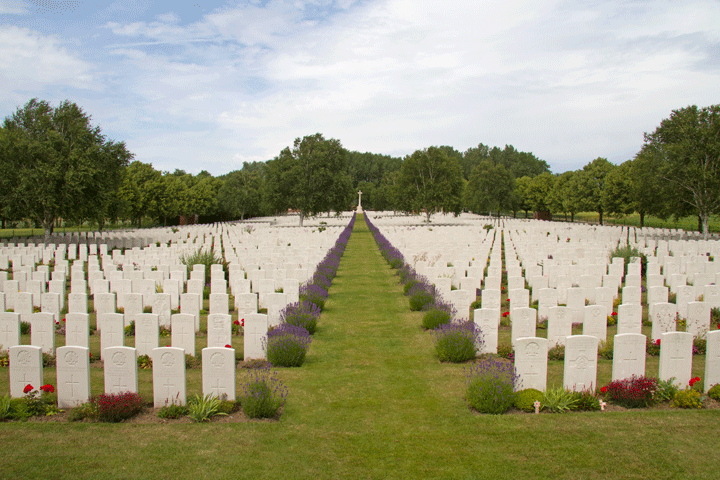
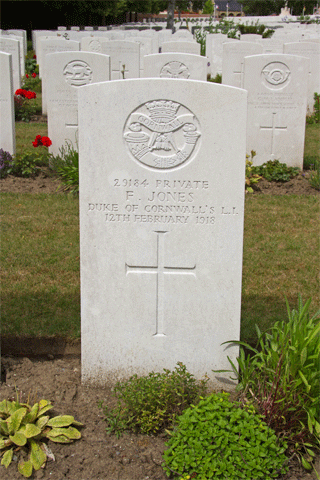
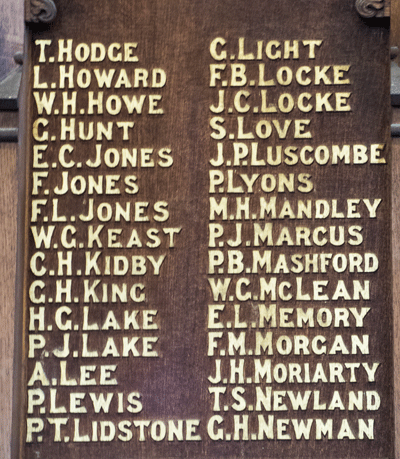
In Dartmouth, Frank is commemorated on the St Saviours Memorial Board, as "F Jones".
By an odd coincidence, Frank's death occurred close to that of his close namesake in Dartmouth, Frank Leslie Newland Jones, who appears on the St Saviours Memorial Board and the Town War Memorial as "F L Jones". Understandably, these two individuals have sometimes been mistaken for each other.
Frank is also commemorated on the War Memorial in Rock Park, Barnstaple, in his full name of "F E J Jones".

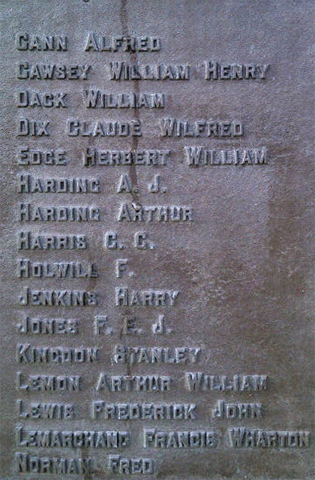
Sources
The War Diary of the 7th Battalion Duke of Cornwall's Light Infantry is available from the National Archives, fee payable for download, reference WO 95/2126/1
The Last Fighting Tommy, by Harry Patch with Richard van Emden, Bloomsbury, Centenary Anniversary Edition, 2013
Information Held on Database
| Surname: | Jones |
| Forenames: | Frank Ernest Joseph |
| Rank: | Private |
| Service Number: | 29184 |
| Military Unit: | 7th Bn Duke of Cornwall's Light Infantry |
| Date of Death: | 12 Feb 1918 |
| Age at Death: | 24 |
| Cause of Death: | Killed in action |
| Action Resulting in Death: | Trench duty |
| Place of Death: | Near Gheluvelt, Ypres |
| Place of Burial: | Buried Hooge Crater Cemetery |
| Born or Lived in Dartmouth? | Yes |
| On Dartmouth War Memorial? | No |
| On St Saviour's Memorials? | Yes |
| On St Petrox Memorials? | No |
| On Flavel Church Memorials? | No |
| In Longcross Cemetery? | No |
| In St Clement's Churchyard? | No |
| On a Private Memorial? | No |
| On Another Memorial? | Yes |
| Name of Other Memorial: | Barnstaple War Memorial |















